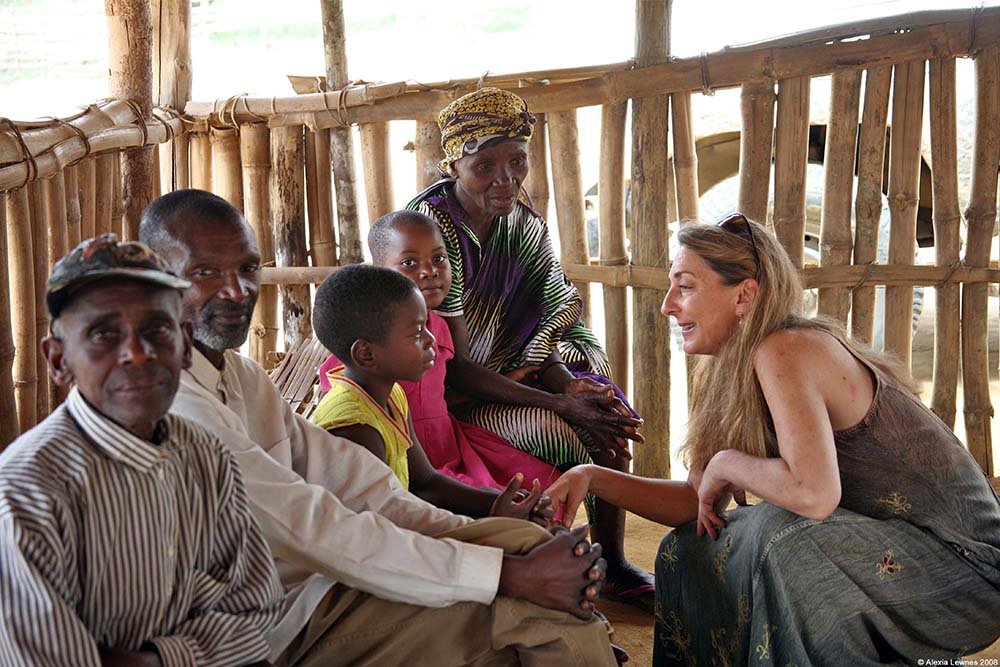
Our Founder’s story
Photo: © Bonobo Conservation InitiativeMama Bonobo
Known in the Democratic Republic of Congo as Mama Bonobo, Sally Jewell Coxe is the co-founder and president of the Bonobo Conservation Initiative. She has been a passionate crusader for bonobos for more than thirty years.
Sally’s journey to the DRC began in her childhood home of western North Carolina. As a girl, Sally loved to ramble around outside, exploring the woods and climbing trees. Over time, she realized that her view of Mt. Pisgah was disappearing due to increasing air pollution. Her concern about what was happening in Asheville was the beginning of her deep commitment to environmental causes. She recognized that environmental decline was a result of human actions. In order to more fully understand human behavior, Sally majored in psychology at Williams College, where she led hiking groups and continued to deepen her connection to the natural world. She was in a deep inquiry about what it means to be a human being; and in the course of her studies, she became fascinated by great apes.
Photo © Bonobo Conservation Initiative
It all began at National Geographic
She first learned about bonobos in 1992 while a senior copywriter at National Geographic. She was working on the promotion for a book called The Great Apes: Between Two Worlds. Though familiar with gorillas, orangutans, and chimpanzees, Sally was blown away to discover that there was a fourth great ape. Bonobos seemed more human-like than the other great apes, and very different from chimpanzees, our other closest relative, in compelling ways that could have a profound impact on human self-understanding. She was deeply fascinated by bonobos’ intelligence, their peaceful matriarchal society, and the role of sexuality and affection in their relationships.
Photo © Bonobo Conservation Initiative
‘I found my calling’
Fueled by her newfound passion, Sally quit her job and dedicated herself to bonobos. She spent the summer of 1993 studying with Dr. Sue Savage-Rumbaugh at Georgia State University. There, Sally developed close bonds with Kanzi and Panbanisha, bonobos who had learned to communicate effectively with humans. They used lexigrams (visual symbols standing for words) to express themselves and understood spoken English. Sally spent time grooming with the bonobos, playing hide-and-seek, and exploring the woods with them. Sally’s profound experiences with the bonobos reinforced her perception of them as very special beings and strengthened her resolve to protect them.
Sally traveled to the DRC (then Zaire) for the first time in 1994 with primatologist Takeshi Furuichi and Savage-Rumbaugh. She spent three months in Wamba, the premier bonobo research site. Sally learned the Congolese language Lingala and delved into the culture of the Bongando people. She collected local folktales which highlighted ancestral taboos against hunting bonobos.

Photo:© Alexia Lewnes

Photo © Bonobo Conservation Initiative

Photo © Bonobo Conservation Initiative

Photo © Bonobo Conservation Initiative

Photo © Bonobo Conservation Initiative

Photo © Bonobo Conservation Initiative
Birth of the Bonobo Peace Forest
The Congo War disrupted travel to the region for several years, but Sally did not cease her efforts. Along with fellow conservationist Alison Mize, Sally founded the Bonobo Conservation Initiative in 1998. From the beginning, they felt it was important to take a multidisciplinary perspective. It was clear that the existing paradigm of conservation was not adequately addressing the underlying issues. Lasting solutions must be rooted in local culture and led by the people who share the bonobo’s home. Creative thinking was needed to secure a future for the bonobos, a new approach that would address the interrelated humanitarian and environmental aspects of rainforest conservation.
In the summer of 2001, Sally met with Congolese conservationists, scientists, and other local stakeholders in Kinshasa. The Congolese participants were clear that they did not want a traditional park where indigenous people are driven off their ancestral lands. During the course of the meeting, a new vision was born, a network of community-managed reserves where humans, wildlife, and the forest all thrive. This moment was the beginning of the Bonobo Peace Forest.
Photo: © Bonobo Conservation Initiative
Building on the Legacy
Since that fateful gathering, the Bonobo Peace Forest has moved from vision to reality. Today, there are several active sites in the Peace Forest, including two officially protected reserves which together span 31,000 kilometers of land. And the Peace Forest continues to grow. While the situation remains dire for bonobos, the Peace Forest offers hope for their future. Sally is always quick to give full credit for this success to BCI staff, partners, and supporters. The truth is that the Bonobo Peace Forest would never have come to fruition without the vision and determination of Sally Jewell Coxe.
Sally continues to work tirelessly on behalf of the bonobos and the Congo forest. In addition to running the daily operations of BCI, Sally travels extensively to speak at conferences, universities, and other venues to raise awareness about bonobos. Just as it was in her youth, Sally’s favorite place is still the forest. She goes on regular expeditions to the heart of the Congo rainforest, drawing inspiration from the bonobos who changed the course of her life; in turn, her work is inspiring others to protect these incredible great apes and their vital habitat for generations to come.
Photo:© Bonobo Conservation Initiative
Get inspired!
Journey to the heart of the Bonobo Peace Forest with Sally Jewell Coxe.
Learn about the critical issues facing bonobos and what we’re doing to help.



